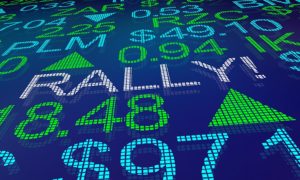Yesterday morning we saw second quarter GDP come in at -0.9%, much lower than the consensus 0.4% estimate. Stocks rallied. Bad news was good news, because it bolstered the current thinking that we are nearing the end of the Fed’s rate hiking cycle.
Today we initially ticked off our highs – not lower, mind you – when the PCE Core Deflator (the Fed’s preferred inflation measure) rose by 0.6%, more than the 0.5% expectation. Stocks recovered, and then took another leg higher after slightly better than expected Michigan Sentiment numbers. Good news was good news.
If good news is good news and bad news is good news, then all news must be good news. QED.
That of course is overly simplistic. Let’s break it down in more depth, taking care of the more intuitive part first.
Of course good news is good news. While the stock market is not the economy, and vice versa, a stronger economy tends to boost the bottom lines of the companies that make up the stock market. If sentiment is good – or in this case not as awful, since we’re near all-time lows for these readings – then consumers are comfortable spending money at their favorite businesses. The consumer sector is about 2/3 of the economy, so a healthy, confident (or not-unconfident) consumer is crucial.
The “bad news is good news” idea requires a bit of psychological jiu-jitsu. It only makes sense if we recognize that equity investors are liquidity addicted, a topic we discussed in detail yesterday. Put simply, risk assets like stocks tend to rise during periods of monetary accommodation. With only brief exceptions, we have seen almost uninterrupted periods of both rising stock prices and monetary quiescence, if not outright stimulus. The mantra “don’t fight the Fed” was certainly a helpful one, especially since 2009.
Investors are betting that the Fed will blink, as they have done time and again. Over the prior 13 years there have been only fleeting periods when the Fed attempted to raise rates and/or withdraw liquidity from the system. Those have been rocky periods, but the Fed typically reversed course rather quickly. That’s how the concept of the “Fed Put” arose — even though history shows that while Fed intervention boosted stocks, it was a welcome side effect from addressing problems elsewhere.
Unfortunately, I now find myself forced to invoke the most dangerous phrase in investing: “this time it’s different.” Those four words can be used to justify almost any sort of harebrained theories, so it needs to be used very judiciously. Ask yourself now, what might we be experiencing now that is significantly different from the prior decade-plus?
Inflation. Of course it’s inflation. We haven’t seen inflation like this for about four decades. It was easy for the Fed to revert to accommodative policies when they didn’t need to be concerned rapid inflation. Rising prices now pose a much greater challenge to a Fed that “is strongly committed to returning inflation to its 2 percent objective.” Even if we have seen peak inflation – at best, debatable after today’s PCE statistics – we are running at levels far above that 2% target.
Thus it appears that investors are questioning the Fed’s resolve. Fed Funds futures show a peak around the February, 2023 meeting. Stocks tend to look six months ahead, and they see that there is a distinct possibility that rates could in fact decrease. Rate cuts are exactly what liquidity addicted investors crave, so it’s not surprising that they are responding positively to that prospect. Combine that with the oversold funk that had been infecting investors’ psyches, and we were primed for a solid rally – especially when earnings came in better than feared.
Is “Don’t Play Chicken with the Fed” a thing? That’s pretty much what we’re doing at this point. Considering the Fed’s recent history of flinching first, it’s understandable. We haven’t seen a Fed this unwilling to blink since the early ‘80s. Oh yeah, that’s also the last time inflation was this high, so let’s see if Chair Powell is more like his predecessor Paul Volcker than investors think.
Disclosure: Interactive Brokers
The analysis in this material is provided for information only and is not and should not be construed as an offer to sell or the solicitation of an offer to buy any security. To the extent that this material discusses general market activity, industry or sector trends or other broad-based economic or political conditions, it should not be construed as research or investment advice. To the extent that it includes references to specific securities, commodities, currencies, or other instruments, those references do not constitute a recommendation by IBKR to buy, sell or hold such investments. This material does not and is not intended to take into account the particular financial conditions, investment objectives or requirements of individual customers. Before acting on this material, you should consider whether it is suitable for your particular circumstances and, as necessary, seek professional advice.
The views and opinions expressed herein are those of the author and do not necessarily reflect the views of Interactive Brokers, its affiliates, or its employees.













![[Gamma] Scalping Please [Gamma] Scalping Please](https://ibkrcampus.com/wp-content/smush-webp/2024/04/tir-featured-8-700x394.jpg.webp)
![[Gamma] Scalping Please [Gamma] Scalping Please](https://ibkrcampus.com/wp-content/uploads/2024/04/tir-featured-8-700x394.jpg)








